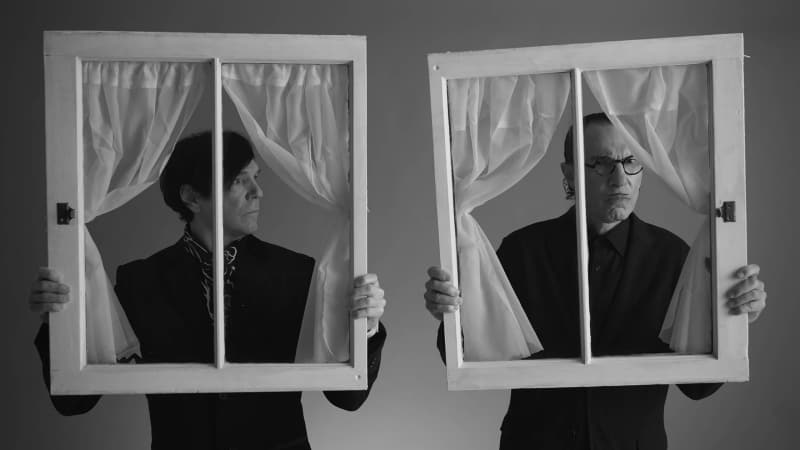
“Sparks are a part of the ecosystem of music,” says a fan, who happens to be Beck, on the lasting influence of a band that’s been sowing seeds across the music industry since the late 1960s. Other famous fans of Sparks, including Jason Schwartzman, Fred Armisen, Weird Al, and Flea, can’t help but sing similar praises of the pop-rock duo in director Edgar Wright‘s documentary debut, The Sparks Brothers.
Comprised of siblings Russell Mael and Ron Mael, Sparks is described by their array of fans as enigmas, true artists, originals. They’ve been prolific and successful yet simultaneously underrated and overlooked. The band has affected such artists as Jack Antonoff, Neil Gaiman, comedian Patton Oswalt, and members of New Order and Duran Duran. Even Paul McCartney once emulated Ron Mael’s striking likeness, complete with his infamous “Adolf Hitler/Charlie Chaplin” mustache, in a music video.
You might hear Sparks’ music in this riveting documentary and feel like you’ve heard it somewhere before but can’t place exactly where, or when, or who was singing it in the first place. They are referred to curiously at one point as a band you can look up on Wikipedia and come away still not really knowing anything about.
That’s what Wright has set out to rectify in The Sparks Brothers (“In lieu of anything better, we hate that name,” Ron Mael proclaims cheekily of the title). The comedy director’s first foray into the world of documentary filmmaking produces a celebratory work of art that is unequivocally original and stylistically all his own, not that dissimilar from the musicians he’s endeavored to spotlight.
Of the plethora of recognizable pop culture icons interviewed for Wright’s documentary, they almost unanimously agree that Sparks has to be one of the most influential music groups of all time, offering disparate hypotheses as to why the Maels’ effect on pop culture has flown so dishearteningly under the radar. As Wright uses humor, engaging anecdotes, and charming animated sequences to chart the course of Sparks’ undeniably powerful presence in the music industry, it becomes clear how a couple of oddball creators subsisting on arthouse films, irony, and their unshakeable sense of humor managed to be everywhere and nowhere at once: through their enduring commitment to each other and their art.
Wright begins by tracing the brothers’ origins in Los Angeles, where they were heavily influenced by their artist father, who died when they were young. Having lived through the rock ‘n’ roll revolution and the golden age of LA’s rock club scene, the brothers eventually took their fervent passion for art, film, and music and turned it into a band of their own, first under the name The Urban Renewal Project and then as Halfnelson, which caught the attention of legendary musician and producer Todd Rundgren.
Although their eponymous debut album did poorly, a change in labels and names — from Halfnelson to “The Sparks Brothers,” inspired by The Marx Brothers, which was then shortened to just Sparks — allowed them to build more momentum. After releasing their follow-up album A Woofer in Tweeter’s Clothing, they traveled to London to tour it, and it was there in the UK where they finally began to build a following — the effects of which are that, to this day, many still think the brothers are British.
But their popularity became something that was unfailingly short-lived, their ups and downs within the industry something of a hallmark of their persona. They were never popular for very long, or in the same place, but perhaps what defined them is that they always, always came back, with a sound unlike anything they’d done before but which was still always wholly theirs.
Over the course of their career, putting out twenty-five albums and nearly five-hundred songs, Sparks’ consistent inconsistency has allowed them to reach a sort of middle ground within the music industry. They’ve never failed to catch the eye of other artists, both big and small, while maintaining a moderate level of success and fanbase that gave them the ability to keep focusing on whatever they wanted to create next.
Marked by their unique visage — Ron Mael a dour-faced, deadpan keyboardist and songwriter with slicked-back hair and that absurd mustache and Russell the eye-catching, dynamic lead vocalist with a mop of Roger Daltrey-inspired hair — and unforgettable album covers and idiosyncratic songs employing the use of bizarre, ironic, and/or comedic lyrics, they became a distinct yet utterly elusive presence.
And all the same, they continued to make music, never concerning themselves with what their fans came to love them for or conceding to what was charting on the Top 40. Instead, they focused on how they next would reinvent themselves and their sound. As one of the many talking heads in The Sparks Brothers suggests regarding why their work hasn’t gone stale (their most recent album having dropped just last year): they have a unilateral distaste for nostalgia. The Maels are only ever looking ahead.
Running well over two hours, the film serves as Wright’s gratuitous love letter to Sparks. He has crafted a filmmaking persona that, perhaps most notably with Baby Driver, has sown itself as inseparable from his soundtracks. The pairing of filmmaker and subject here isn’t random, as music has always been integral to the texture of Wright’s films. For fans of his who might have been unsure how the successful director of vivid comedies like Scott Pilgrim vs. the World and Hot Fuzz would tackle a documentary, it shouldn’t come as a surprise that The Sparks Brothers is no less dynamic than anything else he has ever made.
Aside from interviews with famous faces and with the brothers themselves, the film depicts annotated memories with a variety of delightful animation, ranging from traditional to stop-motion, with even some original art for hypothesized posters and reenactments from the brothers. Wright does all he can to create a documentary as captivating as its subjects, and the pairing of the filmmaker with the duo for this bewitching biography is nothing short of a match made in heaven.
Longtime fans of Sparks have questioned for years what will finally be the band’s big breakthrough, but the magic of Sparks is that there never will be. With theories running the gamut from their toeing the line of being a “comedy band” and the oftentimes alienatingly ironic nature of their lyrics (“throw her away and get a new one”) to their enduring devotion to doing what their fans didn’t want and disavowing any chance at popularity, it all boils down to a single quote uttered by Ron Mael towards the end of the film: “If you don’t like this, we don’t care.”
Even less notable in the mainstream than a kindred artistic spirit such as David Lynch — whose similar dedication to creating the art that fits his own sensibilities has still granted him an elite status in the filmmaking world — Sparks’ inability to break through in any true sense of the word has afforded them a sort of mythic status, which has only added to their enigmatic, hidden gem persona. Their music is buoyed by love — for one another and for their art. Through countless professional setbacks and backing band reconfigurations, the two brothers have never parted.
Although they’ve managed to appear in the Top 10 in the UK four times, Sparks remains an artists’ band, a constant undercurrent of inspiration and guidance in the music and art world that seems far more affecting than if they’d ever broken into true vogue. “Who wants to be really popular?” Sex Pistols guitarist Steve Jones posits at the end of the film. To their immortalized benefit, certainly not Sparks.
Follow all of our Sundance 2021 coverage!
Related Topics: Edgar Wright, Sparks, Sundance, The Sparks Brothers

